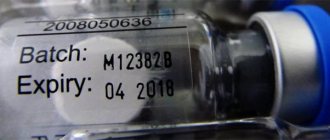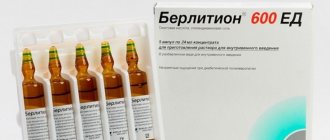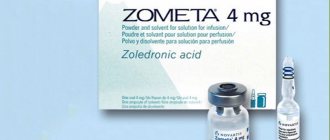pharmachologic effect
Antiaggregant, vasodilator.
The drug PGE1 improves microcirculation and peripheral circulation and has a vasoprotective effect. When administered systemically, it causes relaxation of smooth muscle fibers, has a vasodilating effect, and reduces peripheral vascular resistance without changing blood pressure. In this case, there is a reflex increase in cardiac output and heart rate. Helps increase the elasticity of red blood cells, reduces platelet aggregation and neutrophil activity, increases the fibrinolytic activity of the blood. Has a stimulating effect on the smooth muscles of the intestines, bladder, and uterus; suppresses the secretion of gastric juice.
PGE1 is used in combination with alpha-cyclodextrin IV or IV. During the preparation of the solution, the drug complex breaks down into its component parts - PGE1 and alpha-cyclodextrin. With intravenous administration, a therapeutically significant concentration of the active substance is achieved soon after the start of drug administration, and Cmax in the blood plasma is achieved within 2 hours from the start of administration. PGE 1 is an endogenous substance with an exceptionally short T1/2 - the concentration in the blood plasma returns to its original level within 10 s after cessation of administration. The process of biotransformation of PGE 1 occurs mainly in the lungs; during the “first pass” through the lungs, 60–90% of the active substance is metabolized with the formation of the main metabolites - 15-keto - PGE1, 15-keto - PGE0 and PGE0. The main metabolic products are excreted by the kidneys - 88% and through the gastrointestinal tract - 12% within 72 hours. 93% of PGE1 binds to plasma proteins. Alpha-cyclodextrin has a half-life of about 7 minutes and is excreted unchanged by the kidneys.
Vazaprostan
Vasaprostan (active ingredient alprostadil) is a vasodilator, an analogue of endogenous prostaglandin E1. It is used mainly to treat chronic occlusive (blockage-related) diseases of the arteries. The drug improves blood circulation in the capillary bed, activates peripheral circulation, and exhibits a capillary protective effect. When administered intravenously, it relaxes smooth muscles, has a vasodilating effect, reduces total peripheral vascular resistance, and lowers blood pressure. Against the background of the action of vazaprostan, a reflex increase in minute blood volume and heart rate is observed. The drug improves the rheological characteristics of blood, makes red blood cells more elastic, reduces platelet aggregation (sticking together) of platelets, and promotes fibrinolysis (dissolution of blood clots and blood clots). Vazaprostan has an effect on metabolism, increases the utilization of glucose (primarily due to oxidation) and oxygen, reduces the production of free radicals and lysosome enzymes from macrophages and granulocytes, stimulates protein synthesis, has a positive effect on fat metabolism (inhibits the synthesis of “bad” cholesterol, reducing the concentration of low-density lipoproteins), inhibits the proliferation of smooth muscle tissue. By suppressing the proliferation of smooth muscle cells and inhibiting mitotic activity, the drug inhibits the growth of atherosclerotic plaques, and also helps reduce spasm of blood vessels. At the same time, the drug stimulates the smooth muscle “corset” of the intestines, uterus, bladder, and inhibits the secretion of gastric juice. Vazaprostan has another very specific area of application - the treatment of erectile dysfunction. When administered intracavernosally (into the cavernous bodies of the penis), the drug blocks alpha-1-adrenergic receptors dotting the tissues of the penis, relaxes the smooth muscles of the cavernous bodies, intensifies blood flow and improves blood circulation in the capillaries.
The dilation of the arteries of the penis increases blood flow to the glans, and venous outflow is limited, resulting in an erection. The drug begins to act in 5-10 minutes and retains its effect for 1-3 hours.
Vazaprostan plays an important role in the treatment of critical limb ischemia, which has developed, for example, against the background of obliterating atherosclerosis. In some cases, the use of the drug is the only alternative to limb amputation. Vazaprostan can help even with stage 4 critical limb ischemia. Thanks to the high effectiveness of the drug, it is possible not only to save the limb, but also to significantly improve the prognosis in the presence of gangrene. According to the Russian Academy of Medical Sciences, therapy with vasaprostan in patients with critical limb ischemia ensures the preservation of the integrity of the latter in 95% of cases. Another important aspect of the use of vazaprostan is ischemia of the lower extremities that develops as a result of diabetes mellitus. Thanks to improved glucose utilization, activation of metabolic and trophic processes in tissues, and other positive effects of prostaglandin E, patients experience wound healing and scarring of trophic ulcers. The best effect in such cases is obtained by combining vazaprostan with thioctic acid. The use of the drug is also justified in the case of reconstructive surgery, because vazaprostan prevents the development of thrombosis of the vascular prosthesis and restenosis (repeated narrowing of the artery lumen in the place where the stenosis was surgically eliminated).
Vazaprostan is available in the form of a lyophilisate for the preparation of a solution for infusion. The dosage regimen of the drug is individual.
Directions for use and doses
V/a introduction. Dissolve the contents of 1 ampoule of Vazaprostan® lyophilisate (corresponding to 20 mcg of alprostadil) in 50 ml of physiological solution.
In the absence of other prescriptions, half the contents of the Vazaprostan® ampoule (corresponding to 10 mcg of alprostadil) are administered intravenously over 60–120 minutes using an infusion device. If necessary, especially in the presence of necrosis, under strict tolerance control, it is possible to increase the dose to 20 mcg of alprostadil (contents of 1 ampoule). This dosage is usually used as a single daily infusion.
If intravenous infusion is administered through an inserted catheter, depending on tolerability and severity of the disease, a dose of 0.1–0.6 ng/kg/min is recommended over 12 hours using an infusion device (corresponding to 0.25–0.6 ng/kg/min). 1.5 ampoules of Vazaprostan).
IV infusion. Dissolve the contents of 2 ampoules of Vazaprostan® lyophilisate (corresponding to 40 μg of alprostadil) in 50–250 ml of physiological solution and administer the resulting solution intravenously for 2 hours 2 times a day or 3 ampoules (60 μg of alprostadil) for 3 hours 1 time per day day.
In patients with impaired renal function (renal failure with a creatinine level of more than 1.5 mg/dL), intravenous administration begins with 20 mcg over 2 hours. If necessary, after 2-3 days the single dose is increased to 40-60 mcg.
For patients with renal and heart failure, the maximum volume of fluid administered is 50–100 ml/day. The course of treatment is 4 weeks.
The duration of treatment is on average 14 days; if the effect is positive, treatment with the drug can be continued for another 7–14 days. If there is no positive effect within 2 weeks from the start of treatment, further use of the drug should be discontinued.
Preparation of the solution. The solution must be prepared immediately before the infusion. The lyophilisate dissolves immediately after adding saline. At first, the solution may turn out milky-cloudy. This effect is created by air bubbles and has no significance. After a short time the solution becomes transparent. Do not use a solution prepared more than 12 hours ago.
Vazaprostan 60 mcg 10 pcs. lyophilisate for the preparation of solution for infusion
pharmachologic effect
The vasodilating drug is a synthetic analogue of prostaglandin E1.
Composition and release form Vazaprostan 60 mcg 10 pcs. lyophilisate for the preparation of solution for infusion
Lyophilisate – 1 app.:
- Active ingredient: alprostadil (clathrate complex with alfadex 1:1) 60 mcg;
- Excipients: alphadex (α-cyclodextrin) 1940.0 mcg, anhydrous lactose 47.5 mg.
Alprostadil = PGE1 (prostaglandin E1), INN.
Alphadex = α-cyclodextrin (α-CD), INN.
49.5 mg (corresponding to 60 mcg of alprostadil) in neutral glass ampoules with a blue dot above the cut point and a blue marking ring.
10 ampoules along with instructions for use in a cardboard pack with a special holder for ampoules.
In the case of packaging of the drug at ZAO "
5 ampoules are placed in a blister pack made of polyvinyl chloride film and polymer film or without polymer film.
2 blister packs of 5 ampoules each, along with instructions for use, are placed in a cardboard pack.
Description of the dosage form
Hygroscopic lyophilic mass of white color.
Characteristic
The white lyophilisate is collected at the bottom of the ampoule and forms a layer about 3 mm thick. After complete dissolution of the lyophilisate in physiological solution, it becomes a clear, colorless liquid.
Directions for use and doses
The solution must be prepared immediately before the infusion. The lyophilisate dissolves immediately after adding saline. At first, the solution may appear milky-cloudy. This effect is created by air bubbles and is not significant. After a short time the solution becomes transparent.
It is not allowed to use a solution prepared more than 12 hours ago.
Intra-arterial administration
Lyophilisate for the preparation of solution for infusion: 1 amp./20 mcg alprostadil
To obtain a solution for intravenous administration, the contents of 1 ampoule of lyophilisate (corresponding to 20 mcg of alprostadil) should be dissolved in 50 ml of physiological solution. In the absence of other prescriptions, half an ampoule of Vazaprostan (corresponding to 10 mcg of alprostadil) should be administered intravenously over 60-120 minutes using an infusion device. If necessary, especially in the presence of necrosis, under strict tolerance control, the dose can be increased to 1 ampoule (20 mcg alprostadil). This dose is usually used as a single daily infusion.
If intravenous administration of the drug is carried out through an installed catheter, depending on tolerability and severity of the disease, a dose of 0.1-0.6 ng/kg/min is recommended with the drug administered over 12 hours using an infusion device (corresponds to 1/4-11/ 2 ampoules of Vazaprostan).
Lyophilisate for the preparation of solution for infusion: 1 amp./60 mcg of alprostadil
To obtain a solution for intravenous administration, the contents of 1 ampoule of lyophilisate (corresponding to 60 mcg of alprostadil) should be dissolved in 50-250 ml of physiological solution. In the absence of other prescriptions, 1/6 ampoule of Vazaprostan (corresponding to 10 mcg of alprostadil) should be administered intravenously over 60-120 minutes using an infusion device. If necessary, especially in the presence of necrosis, under strict tolerance control, the dose can be increased to 1/3 ampoule (20 mcg alprostadil). This dose is usually used as a single daily infusion.
If intravenous administration of the drug is carried out through an installed catheter, depending on tolerability and severity of the disease, a dose of 0.1-0.6 ng/kg/min is recommended with the drug administered over 12 hours when using an infusion device (corresponds to 1/12-1/ 2 ampoules of Vazaprostan).
Intravenous administration
Lyophilisate for the preparation of solution for infusion: 1 amp./20 mcg alprostadil
To obtain a solution for intravenous administration, the contents of 2 ampoules of lyophilisate (corresponding to 40 mcg of alprostadil) should be dissolved in 50-250 ml of physiological solution and the resulting solution should be administered intravenously over 2 hours. This dose is applied 2 times a day.
Or the contents of 3 ampoules (corresponding to 60 mcg of alprostadil) are dissolved in 50-250 ml of physiological solution and administered intravenously for 3 hours 1 time per day.
The average duration of treatment is 14 days; if the effect is positive, treatment with the drug can be continued for another 7-14 days. If there is no positive effect within 2 weeks from the start of treatment, further use of the drug should be discontinued.
Lyophilisate for the preparation of solution for infusion: 1 amp./60 mcg of alprostadil
To obtain a solution for intravenous administration, the contents of 1 ampoule of lyophilisate (corresponding to 60 mcg of alprostadil) should be dissolved in 50-250 ml of physiological solution and the resulting solution should be administered intravenously for 3 hours, 1 time per day.
The average duration of treatment is 14 days; if the effect is positive, treatment with the drug can be continued for another 7-14 days. If there is no positive effect within 2 weeks from the start of treatment, further use of the drug should be discontinued.
In patients with renal failure (serum creatinine more than 1.5 mg/dl), intravenous administration of Vazaprostan should begin with 20 mcg (1 amp. 20 mcg or 1/3 amp. 60 mcg) for 2 hours. If necessary, after 2- After 3 days, the single dose is increased to 40-60 mcg.
For patients with renal and heart failure, the maximum volume of fluid administered is 50-100 ml/day. The course of treatment is 4 weeks.
Pharmacodynamics
Prostaglandin E1 (PG E1) preparation. Improves microcirculation and peripheral circulation, has a vasoprotective effect.
When administered systemically, it causes relaxation of smooth muscle fibers, has a vasodilating effect, and reduces peripheral vascular resistance without changing blood pressure. In this case, there is a reflex increase in cardiac output and heart rate.
Helps increase the elasticity of red blood cells, reduces platelet aggregation and neutrophil activity, increases the fibrinolytic activity of the blood.
Has a stimulating effect on the smooth muscles of the intestines, bladder, and uterus; suppresses the secretion of gastric juice.
Pharmacokinetics
Used in combination with alphacyclodextrin IV or V/A. During the preparation of the solution, the drug complex breaks down into its component parts - PG E1 and alphacyclodextrin.
Suction
With intravenous administration, a therapeutically significant concentration of the active substance is achieved soon after the start of drug administration, and Cmax in the blood plasma is achieved within 2 hours from the start of administration.
Distribution
PG E1 is 93% bound to plasma proteins.
Metabolism
The process of biotransformation of PG E1 occurs mainly in the lungs; during the “first pass” through the lungs, 60-90% of the active substance is metabolized with the formation of the main metabolites - 15-keto-PG E1, 15-keto-PG E0 and PG E0.
Removal
PG E1 is an endogenous substance with an exceptionally short T1/2. The concentration in the blood plasma returns to the initial level 10 seconds after cessation of administration. It is excreted in the form of metabolites in the urine (88%) and through the gastrointestinal tract (12%) within 72 hours.
T1/2 of alphacyclodextrin is about 7 minutes and is excreted unchanged in the urine.
Indications for use Vazaprostan 60 mcg 10 pcs. lyophilisate for the preparation of solution for infusion
Chronic obliterating diseases of the arteries of stages III and IV (according to Fontaine classification).
Contraindications
- chronic heart failure in the stage of decompensation;
- severe heart rhythm disturbances;
- exacerbation of ischemic heart disease;
- myocardial infarction in the last 6 months;
- pulmonary edema;
- infiltrative lung diseases;
- chronic obstructive pulmonary diseases;
- liver dysfunction (increased levels of AST, ALT, GGT);
- history of liver disease;
- diseases accompanied by an increased risk of bleeding (peptic ulcer of the stomach and duodenum, severe damage to the blood vessels of the brain, proliferative retinopathy with a tendency to bleeding, extensive trauma);
- concomitant therapy with vasodilators and anticoagulant drugs;
- pregnancy;
- lactation period (breastfeeding);
- age under 18 years (efficacy and safety have not been established);
- hypersensitivity to alprostadil and other components of the drug.
Vazaprostan should be prescribed with caution in case of arterial hypotension, cardiovascular failure (monitoring the volume load of the carrier solution is required), patients on hemodialysis (treatment should be carried out in the post-dialysis period), patients with type 1 diabetes mellitus, especially with extensive vascular lesions.
Application of Vazaprostan 60 µg 10 pcs. lyophilisate for the preparation of solution for infusion during pregnancy and lactation
The use of Vazaprostan during pregnancy is contraindicated.
If it is necessary to use the drug during lactation, breastfeeding should be stopped.
Contraindication: age under 18 years (efficacy and safety have not been established).
special instructions
Vazaprostan can only be used by doctors who have experience in angiology, are familiar with modern methods of continuous monitoring of the cardiovascular system and have the appropriate equipment for this.
When carrying out therapy with Vazaprostan, blood pressure, heart rate, biochemical blood parameters, blood clotting indicators should be monitored (in case of disorders of the blood coagulation system or during simultaneous therapy with drugs that affect the coagulation system).
During treatment with Vazaprostan, in order to avoid the appearance of symptoms of overhydration in patients with renal failure, the volume of administered fluid should be limited to 50-100 ml/day. Dynamic monitoring of the patient’s condition is necessary (monitoring blood pressure and heart rate), if necessary, monitoring body weight, fluid balance, measuring central venous pressure or conducting an echocardiographic study.
Patients with coronary artery disease, peripheral edema and impaired renal function (serum creatinine more than 1.5 mg/dl) during treatment with Vazaprostan and for 1 day after discontinuation of the drug should be monitored in a hospital.
Phlebitis (proximal to the injection site) is usually not a reason to discontinue therapy; symptoms of inflammation disappear within a few hours after stopping the infusion or changing the injection site. No specific treatment is required in such cases. Central vein catheterization can reduce the incidence of this side effect of the drug.
Impact on the ability to drive vehicles and operate machinery
Vazaprostan may affect the ability to actively participate in street traffic, drive vehicles or operate machinery, especially at the beginning of treatment, with increasing doses and withdrawal of the drug, as well as while taking alcohol.
Overdose
Symptoms: decreased blood pressure, increased heart rate, possible development of vasovagal reactions (pallor of the skin, increased sweating, nausea, vomiting), which may be accompanied by myocardial ischemia and symptoms of heart failure; Pain, swelling and redness of the tissue at the infusion site may occur.
Treatment: it is necessary to reduce the dose of the drug or stop the infusion. If there is a pronounced decrease in blood pressure, the patient in a lying position needs to raise his legs. If symptoms persist, sympathomimetics should be used.
Side effects Vazaprostan 60 mcg 10 pcs. lyophilisate for the preparation of solution for infusion
From the central nervous system and peripheral nervous system: headache, dizziness, convulsive syndrome, increased fatigue, feeling of malaise, impaired sensitivity of the skin and mucous membranes.
From the cardiovascular system: decreased blood pressure, chest pain, heart rhythm disturbances, AV block.
From the digestive system: discomfort in the epigastrium, nausea, vomiting, diarrhea.
From the musculoskeletal system: hyperostosis of long tubular bones (with therapy for more than 4 weeks).
Allergic reactions: skin rash, itching.
Local reactions: erythema, swelling, pain, sensory disturbance, phlebitis (proximal to the IV injection site).
Other: increased sweating, hyperthermia, swelling of the limb into which the infusion is administered.
Laboratory indicators: leukocytosis, leukopenia, increased titer of C-reactive protein, increased transaminase levels.
Rarely: arthralgia, confusion, central convulsions, fever, chills, bradypnea, psychosis, renal failure, anuria. Several cases of pulmonary edema and acute left ventricular failure have been reported.
Extremely rare (up to 1% of cases): shock, acute heart failure, hyperbilirubinemia, bleeding, drowsiness, bradypnea, decreased respiratory function, tachypnea, anuria, renal dysfunction, hypoglycemia, ventricular fibrillation, 2nd degree AV block, supraventricular arrhythmia, tension neck muscles, increased irritability, hypothermia, hypercapnia, skin hyperemia, hematuria, peritoneal symptoms, tachyphylaxis, hyperkalemia, thrombocytopenia, anemia.
Side effects associated with the use of the drug or the catheterization procedure itself are reversible after reducing the dose or stopping the infusion.
Drug interactions
With simultaneous use, Vazaprostan may enhance the effect of antihypertensive drugs, peripheral vasodilators, and antianginal drugs.
When Vazaprostan is used in combination with anticoagulants, platelet aggregation inhibitors, cefamandole, cefoperazone, cefotetan, and thrombolytics, the risk of bleeding increases.
With simultaneous use of Vazaprostan with epinephrine (adrenaline), norepinephrine (norepinephrine), the vasodilating effect is reduced.
It must be taken into account that interaction is possible if the above drugs were used shortly before therapy with Vazaprostan was started.
Contraindications
Hypersensitivity to alprostadil and other components of the drug, chronic heart failure, severe cardiac arrhythmias, exacerbation of coronary artery disease, previous myocardial infarction (within the next 6 months), pulmonary edema, infiltrative pulmonary disease, chronic obstructive pulmonary disease, liver dysfunction (increased AST levels , ALT or GGT) and a history of liver disease, as well as diseases accompanied by an increased risk of bleeding and hemorrhage (peptic ulcer of the stomach or duodenum, severe cerebral vascular damage, proliferative retinopathy with a tendency to bleed, extensive trauma, etc. ), concomitant therapy with vasodilators and anticoagulants, pregnancy, breastfeeding.
Contraindicated during pregnancy. Breastfeeding should be stopped during treatment.
Indications for use
- The need to temporarily maintain the functioning of the ductus arteriosus until corrective surgery is performed for congenital ductus-dependent heart defects in newborns (including mitral atresia, pulmonary atresia, tricuspid valve atresia, tetralogy of Fallot).
- Chronic obliterating diseases of the arteries, stage III-IV (according to Fontaine classification).
- Obliterating endarteritis with severe “intermittent” claudication (with impossible surgical revascularization of the lower limb), obliterating atherosclerosis, diabetic angiopathy, thromboangiitis obliterans (Buerger’s disease), Raynaud’s syndrome with trophic disorders, vasculitis, scleroderma, cramps of the calf muscles, the damaging influence of physical factors, especially super-limit vibration.
- Treatment of erectile dysfunction of neurogenic, vascular, psychogenic or mixed etiology; conducting a pharmacological test as part of a set of diagnostic tests for erectile dysfunction.
Overdose
Symptoms: decreased blood pressure, increased heart rate. Vasovagal reactions may develop with pallor of the skin, increased sweating, nausea and vomiting, which may be accompanied by myocardial ischemia and symptoms of heart failure, as well as possible pain, swelling and redness of the tissue at the infusion site.
Treatment: it is necessary to reduce the dose of the drug or stop the infusion. If there is a pronounced decrease in blood pressure, the patient in a lying position needs to raise his legs. If symptoms persist, sympathomimetics should be used.
Precautionary measures
Use Vazaprostan® with caution in case of arterial hypotension, cardiovascular failure (special attention should be paid to monitoring the load with the volume of the carrier solution), in patients on hemodialysis (treatment with the drug should be carried out in the post-dialysis period), in patients with type 1 diabetes mellitus, especially with extensive vascular lesions.
Vazaprostan® may affect the ability to actively participate in street traffic or operate machinery, especially at the beginning of treatment, with increasing doses and withdrawal of the drug, as well as with simultaneous intake of alcohol.
Side effects
From the nervous system: headache, convulsive syndrome, dizziness, increased fatigue, feeling of malaise, impaired sensitivity of the skin and mucous membranes.
From the cardiovascular system: decreased blood pressure, chest pain, heart rhythm disturbances, AV block.
From the digestive system: a feeling of discomfort in the epigastric region, dyspeptic symptoms - diarrhea, nausea, vomiting.
From the musculoskeletal system: hyperostosis of long tubular bones (with treatment for more than 4 weeks).
Local reactions: pain, swelling, erythema, sensory disturbance, phlebitis (proximal to the IV injection site).
Laboratory indicators: leukocytosis, leukopenia, increased titer of C-reactive protein, increased transaminase levels.
Other: increased sweating, hyperthermia, swelling of the limb into which the infusion is administered.
Rarely: joint pain, confusion, central convulsions, fever, chills, bradypnea, arthralgia, psychosis, renal failure, anuria. Several cases of pulmonary edema and acute left ventricular failure have been reported.
Extremely rare (up to 1% of cases): shock, acute heart failure, hyperbilirubinemia, bleeding, drowsiness, bradypnea, decreased respiratory function, tachypnea, anuria, renal dysfunction, hypoglycemia, ventricular fibrillation, 2nd degree AV block, supraventricular arrhythmia, tension neck muscles, increased irritability, hypothermia, hypercapnia, skin hyperemia, hematuria, peritoneal symptoms, tachyphylaxis, hyperkalemia, thrombocytopenia, anemia.
Allergic reactions: skin rash, itching.
Side effects associated with the use of the drug or with the catheterization procedure itself disappear after reducing the dose or stopping the infusion.
special instructions
Alprostadil can only be used by doctors who have experience in angiology, are familiar with modern methods of continuous monitoring of the cardiovascular system and have the appropriate equipment for this.
During the treatment period, it is necessary to monitor blood pressure, heart rate, biochemical blood parameters, and the blood coagulation system (in case of disorders of the blood coagulation system or during simultaneous therapy with drugs that affect the coagulation system).
Patients with coronary artery disease, as well as patients with peripheral edema and renal dysfunction (serum creatinine >1.5 mg/dL) should be monitored in the hospital during treatment with Vazaprostan® for 1 day after stopping its use.
To avoid the appearance of symptoms of overhydration in patients with renal failure, the volume of fluid administered should, if possible, not exceed 50–100 ml/day. Dynamic monitoring of the patient's condition is mandatory: monitoring blood pressure and heart rate, and, if necessary, monitoring body weight, fluid balance, measuring central venous pressure or conducting an echocardiographic study.
Phlebitis (proximal to the injection site), as a rule, is not a reason to discontinue therapy; signs of inflammation disappear a few hours after stopping the infusion or changing the injection site; specific treatment is not required in such cases. Central vein catheterization can reduce the incidence of this side effect of the drug.
If the ampoule is damaged, the lyophilisate becomes wet and sticky, and greatly decreases in volume. In this case, the drug cannot be used.
Vazaprostan liof.d/prig.solution d/inf.60mkg amp.No.10 90434
Description
Vazaprostan® lyophilisate for the preparation of solution for infusion 60 mcg; ampoule, cardboard pack 10; EAN code: 4030729000957; No. LSR-001051/08, 2008-02-26 from Schwarz Pharma (Germany); manufacturer: Bayer HealthCare AG (Germany) Latin name Vazaprostan® Active ingredient Alprostadil * (Alprostadilum) ATC: C01EA01 Alprostadil Pharmacological groups Prostaglandins, thromboxanes, leukotrienes and their antagonists Angioprotectors and microcirculation correctors Indications Concentrate/lyophilisate for preparing a solution for infusion: chronic obliterating peripheral diseases them arteries of stages III–IV (according to Fontaine’s classification), accompanied by pain at rest or trophic changes. Obliterating endarteritis with severe intermittent claudication (unless surgical intervention is indicated), atherosclerosis of the arteries of the extremities, diabetic angiopathy, thromboangiitis obliterans (Buerger's disease), Raynaud's syndrome with trophic disorders, vasculitis, systemic scleroderma, cramps of the calf muscles, peripheral circulatory disorders as a result of damaging effects physical factors, especially extreme vibration. Congenital ductus-dependent heart defects in newborns (for temporary maintenance of the functioning of the ductus arteriosus before reconstructive cardiac surgery), incl. mitral atresia, pulmonary atresia, tricuspid valve, tetralogy of Fallot. Lyophilisate for preparing a solution for intracavernous administration: erectile dysfunction of neurogenic, vascular, psychogenic or mixed etiology; conducting a pharmacological test in the diagnosis of erectile dysfunction. Contraindications Concentrate/lyophilisate for preparing solution for infusion: hypersensitivity, pregnancy, breastfeeding. In neonatology: depression of respiratory function, respiratory distress syndrome, state of spontaneous persistently open ductus arteriosus. Lyophilisate for preparing a solution for intracavernous administration: hypersensitivity, predisposition to prolonged erection (sickle cell anemia, including if suspected, multiple myeloma, leukemia, etc.), anatomical deformations of the penis (angulation, cavernous fibrosis, Peyronie's disease) , stricture of the urethra, hypospadias, age under 18 years and over 75 years (there is no experience with these groups of patients); men for whom sexual activity is contraindicated or not recommended; presence of a penile implant. Side effects With infusion administration From the nervous system and sensory organs: headache, dizziness, paresthesia, convulsive syndrome, increased fatigue, feeling of malaise, impaired sensitivity of the skin and mucous membranes; rarely - confusion, psychosis. From the cardiovascular system and blood (hematopoiesis, hemostasis): decreased blood pressure, tachycardia, cardialgia, heart rhythm disturbances, AV block, redness of the skin; rarely - development or worsening of heart failure, leukopenia or leukocytosis. From the respiratory system: shortness of breath; rarely - respiratory distress syndrome, acute pulmonary edema. From the gastrointestinal tract: discomfort in the epigastric region, nausea, vomiting, diarrhea, increased activity of liver transaminases; rarely - hyperbilirubinemia. From the genitourinary system: rarely - renal failure, hematuria. From the musculoskeletal system: arthralgia; with long-term continuous use (more than 4 weeks) - reversible hyperostosis of tubular bones. Allergic reactions: skin rashes, urticaria, itching. Other: increased sweating, hyperthermia, chills, swelling of the limb into which the infusion is being administered; rarely - an increase in the titer of C-reactive protein; reactions at the injection site - pain, swelling, erythema, sensitivity disorder, phlebitis proximal to the IV injection site (up to 40% of patients). Extremely rare (up to 1% of cases): shock, acute heart failure, hyperbilirubinemia, bleeding, drowsiness, bradypnea, decreased respiratory function, tachypnea, anuria, renal dysfunction, hypoglycemia, ventricular fibrillation, 2nd degree AV block, supraventricular arrhythmia, tension neck muscles, increased irritability, hypothermia, hypercapnia, skin hyperemia, hematuria, peritoneal symptoms, tachyphylaxis, hyperkalemia, thrombocytopenia, anemia. In newborns: apnea (frequency 10–12%), elevated temperature (14%), hyperemia of the skin (about 10%, especially with intravenous administration), bradycardia (7%), decreased blood pressure (4%), convulsions ( 4%), tachycardia (3%); about 2% - diarrhea, sepsis; about 1% - cardiac arrest, edema, disseminated intravascular coagulation syndrome, hypokalemia; ≤1% - cerebral hemorrhage, excessive neck extension, hypothermia, nervous agitation, lethargy, congestive heart failure, 2nd degree AV block, supraventricular tachycardia, ventricular fibrillation, bradypnea, stridor, hypercapnia, respiratory depression, tachypnea, gastric regurgitation, hyperbilirubinemia , anemia, bleeding, thrombocytopenia, anuria, hematuria, peritoneal symptoms, hypoglycemia, hyperkalemia; with long-term treatment (several weeks), hyperostosis in the bones of the lower extremities has been reported (see also “Precautions”). With intracavernosal injection Local reactions: pain in the penis (37%), excessively prolonged erection (up to 4-6 hours - 4%), hematoma (3%) and ecchymosis (2%) at the injection site (associated with incorrect injection technique) , formation of fibrous nodules and Peyronie's disease (3–8%), swelling of the penis (1%), rash on the penis (1%); less than 1% - priapism (0.4%), balanitis, hemorrhages at the injection site; inflammation, itching and swelling at the injection site, bleeding from the urethra, penile disorders, incl. feeling of heat in the penis, numbness, fungal infection, irritation, hypersensitivity, phimosis, rash, erythema, venous discharge, painful erection, ejaculation disorder. Systemic effects (rare): pain and swelling of the scrotum and testicles, increased frequency of urination, urinary incontinence, fluctuations in blood pressure (increase or decrease), tachycardia, supraventricular extrasystole, impaired peripheral circulation, fatigue, headache, hypoesthesia, swelling of the legs, hyperhidrosis, nausea, dry mouth, increased serum creatinine, calf muscle cramps, weakness in the buttocks, localized pain (in the chest, buttocks, pelvis, legs, genitals, abdomen), mydriasis, influenza-like syndrome. Precautionary measures Alprostadil for infusions can only be used by doctors with experience in angiology, familiar with modern methods of continuous monitoring of the state of the cardiovascular system and who have the appropriate equipment for this. During the treatment period, monitoring of blood pressure, heart rate, biochemical parameters and blood coagulation is necessary (in case of disorders of the blood coagulation system or during simultaneous therapy with drugs that affect the coagulation system). Patients with coronary artery disease, as well as patients with peripheral edema and renal dysfunction (serum creatinine >1.5 mg/dL) should be monitored in the hospital during treatment with alprostadil and for 24 hours after its cessation. To avoid the appearance of symptoms of overhydration in patients with renal failure, the volume of fluid administered should, if possible, not exceed 50–100 ml/day. Dynamic monitoring of the patient's condition is mandatory: monitoring blood pressure and heart rate, and, if necessary, monitoring body weight, fluid balance, measuring central venous pressure or conducting an echocardiographic study. Phlebitis (proximal to the injection site), as a rule, is not a reason to discontinue therapy; signs of inflammation disappear a few hours after stopping the infusion or changing the injection site; No specific treatment is required in such cases. Central vein catheterization can reduce the incidence of this side effect of the drug. Due to the risk of apnea in newborns, alprostadil should be used in institutions with qualified personnel and equipment necessary to provide intensive care for children, under constant monitoring of blood pressure, with conditions for immediate mechanical ventilation. Apnea (see Side Effects) is most common in neonates weighing less than 2 kg at birth and usually occurs within the first hour of infusion. Administration of alprostadil to newborns can lead to obstruction of the pylorus. This effect appears to depend on the duration of therapy and the cumulative dose of the drug. Neonates receiving alprostadil at recommended doses for more than 120 hours should be monitored closely. When treating erectile dysfunction, treatmentable causes of erectile dysfunction should be diagnosed before starting alprostadil therapy. Dose selection must be carried out individually for each patient, under the supervision of a doctor, with monitoring of the state of the cardiovascular system and the duration of erections. To reduce the likelihood of developing a prolonged erection or priapism when selecting a dose, it is necessary to increase it slowly until the minimum effective dose is reached (the appearance of an erection lasting no more than 1 hour and sufficient for sexual intercourse). During dose selection, the patient should be under medical supervision until the erection disappears. If the first dose is ineffective, a second, higher dose can be administered no earlier than 1 hour later. If there is a response, the interval between doses should be at least 1 day. Self-injections can be prescribed to patients only after detailed instructions to the patient and mastering the technique of self-injections. Treatment begins with a dose selected by the doctor. The patient is recommended to visit the attending physician every 3 months to assess the effectiveness and safety of treatment and, if necessary, to adjust the dose. The patient should be warned that during treatment he must inform the doctor about all cases of erection lasting more than 4 hours. Untimely correction of priapism can lead to irreversible damage to the tissue of the penis and long-term loss of potency. Alprostadil is not intended for simultaneous use with other drugs for the treatment of erectile dysfunction. Special instructions The compliance of the dosage form of alprostadil with the specific indications for its use should be strictly observed. Do not mix with solutions of other drugs. Storage conditions for the drug Vazaprostan® At a temperature not exceeding 25 °C. Keep out of the reach of children. The shelf life of Vazaprostan® is 4 years. Do not use after the expiration date stated on the package. 2000-2015. Register of Medicines of Russia The database is intended for healthcare professionals. Commercial use of materials is not permitted.
Possible product names
- Vazaprostan por d/infusion solution 60 µg amp N10
- VAZAPROSTAN 60 MCG DRY SUBSTANCE AMP.№10
- VAZAPROSTAN 60MCG N10 AMP LIOF D/R-RA D/INF
- VAZAPROSTAN LIOF. D/PRIG. R-RA D/INF. 0.06 MG AMP. X10
- VAZAPROSTAN LIOF. COOK. R-RA D/INF. 60mcg AMP. No. 10
- VAZAPROSTAN 60MCG LIOF. D/PRIG. R-RA D/INF. AMP. X10 B M (R)
- (Vazaprostan) Vazaprostan por d/infusion solution 60 µg amp N10
Drug interactions
Vazaprostan® may enhance the effect of antihypertensive drugs, vasodilators and antianginal drugs. The simultaneous use of Vazaprostan® in patients taking drugs that prevent blood clotting (anticoagulants, platelet aggregation inhibitors) may increase the likelihood of bleeding. In combination with cefamandole, cefoperazone, cefotetan and thrombolytics, it increases the risk of bleeding. Sympathomimetics - adrenaline, norepinephrine - reduce the vasodilating effect.
It must be taken into account that drug interactions are possible even if the above drugs were used shortly before Vazaprostan® therapy was started.







